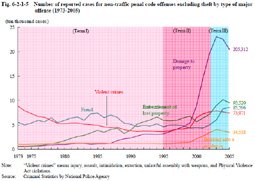| Previous Next Index Image Index Year Selection | |
|
|
3 Reported cases for non-traffic penal code offenses excluding theft
Changes in the number of reported cases for non-traffic penal code offenses excluding theft did not have much influence on the overall trend in Terms I and II. However, their ratio among the total number of reported cases for non-traffic penal code offenses, which was 18.2% in 1973, 11.9% in 1995, and 16.7% in 2002, increased to 24.0% in 2005, showing an upward trend in Term III. Their changes came to have larger impact on the overall trend.
Fig. 6-2-1-5 shows trends in the number of reported cases for non-traffic penal code offenses excluding theft by type of major offense. Fig. 6-2-1-5 Number of reported cases for non-traffic penal code offenses excluding theft by type of major offense (1973-2005) In Term I, embezzlement of lost property and damage to property showed an upward trend, while violent crimes (meaning injury, assault, intimidation, extortion, unlawful assembly with weapons, and Physical Violence Act violations; hereinafter the same) and fraud were declining, with the overall number remaining almost flat. However, many crimes started to increase in the latter half of Term II. Among violent crimes, injury and assault showed increases from 2000, and damage to property also increased significantly from the same year, showing an increase of nearly 6.3-fold from 31,231 cases in 1995 to 196,018 cases in 2002. The significant increase in the number of damage to property increases the total number of reported cases for non-traffic penal code offenses excluding theft in Term II. In addition to these, embezzlement of lost property, fraud, and breaking into a residence have continued to increase even in Term III.We will examine the details of damage to property, which was the major cause of the sharp increase of the total number of reported cases for non-traffic penal code offenses excluding theft in Term II. Fig. 6-2-1-6 shows the percent ratio of damage to property by contents in 2005. Fig. 6-2-1-6 Percent ratio of damage to property by contents (2005) More than half of damaged objects were vehicles and nearly 50% of incidence in total occurred in auto (bicycle) parks or on roads. Theft from vehicles increased sharply in Term II, which implies that the significant increase in non-traffic penal code offenses was brought about mainly by the increase in offenses targeting vehicles.In Term III, such offenses targeting vehicles seem to be declining due to strengthened countermeasures, but the number of other offenses has mostly remained at a high level. In particular, assault and fraud continued to increase even in 2005 (see Part 1, Chapter, 1, Section 1, 1), and the overall situation concerning crimes is still far from an improvement. Furthermore, we should note the appearance of an advanced information society which has brought about new types of offenses utilizing cellular phones, the Internet, and other new technologies. Counterfeiting of currencies utilizing PCs and fraud utilizing the Internet, as well as billing fraud are increasing significantly in recent years (see Part 1, Chapter 1, Section 2 and Part 1, Chapter 3, Section 3). There has also been a phenomenon that offenses likely to inspire copycats such as robbery targeting convenient stores, street robbery, and robbery at financial institutions increase significantly nationwide in a short period of time. In order to prevent such new offenses emerging one after another, swift and effective countermeasures are strongly required. |

